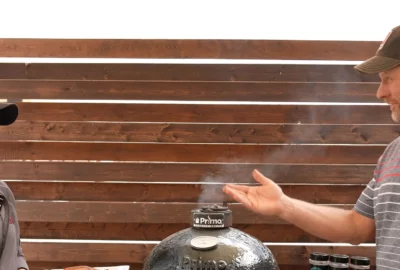Smoking & Grilling World
How the Color of Smoke Affects Flavor
Smoking meat is an age-old culinary tradition that brings a unique and irresistible flavor to various cuts of meat. From tender ribs to succulent brisket and pork shoulder, the art of smoking infuses an array of delicious flavors into these cuts. However, the taste of the final product can vary significantly based on two critical factors: the cooking temperature and the color of the smoke. In this blog post, we will explore how these factors impact the flavor of smoked meat and why mastering the art of smoke will give you a new level of control over your cooks. In a future post, I will look at how temperature affects your food while discussing low and slow versus fast and hot cooking preferences.

Many of us get too impatient when it comes to starting briquettes with a chimney. The batch above took almost 45 minutes, with one starter cube.
To get a better understanding of this topic I called a long-time friend of FireBoard, Meathead Goldwin. If you are not familiar with Meathead, visit his website AmazingRibs.com or pick up one of his books. His series of “Deep Dive” cookbooks will train you on the finer points of smoking brisket, chicken, ribs, and even how to make bbq with sous vide. Meathead: The Science of Great Barbecue and Grilling is a fantastic catch-all bbq cookbook that explains the physics and chemistry that goes into making your meal. He is as passionate about live-fire cooking as he is knowledgeable. All of his books and articles revolve around his concept that “cooking is a chemistry and physics experiment,” and Meathead is your tutor.
When I asked Meathead about the different varieties of smoke and its effect on the food, he explained that “smoke is one of the most interesting and complicated aspects of barbecue.” He went on to say that “smoke is a spice.” Like all spices too little is ineffective and too much is undesirable.

Adding chunks of aromatic hardwood to glowing charcoal is one of the most efficient methods to yield good smoke.
The best way to control smoke flavor is to know the difference between good and bad smoke, what it looks like, and how to make it.
The Role of Smoke Color:
Smoke is a mixture of tiny particles, gases, and water vapor produced by burning fuels like charcoal or wood. When wood burns, it releases different compounds, and each compound contributes to the overall flavor.
Thin Blue Smoke
Blue smoke is considered the ideal smoke color for smoking meat. It results from a clean and efficient combustion process, producing a bluish tint in the smoke. Blue smoke indicates that the wood is burning at the right temperature and that the meat will absorb a mild, delicate flavor without being overwhelming.
Puffy White Smoke
White smoke is usually produced when the fire is not burning hot enough or when using unseasoned wood. It contains more water vapor and larger particles, which can lead to a harsh, bitter flavor. Overexposure to white smoke can overpower the meat’s natural taste and result in an undesirable, unpleasant experience.

White smoke from warming up our Yoder Pizza oven on a cold December day, once the cooker was above 275ºF, the smoke was nearly invisible.
Other colors
Other colors you may encounter include thick smoke, tinged with grey, yellow, brown, or completely black. All of these are signs of different chemical compounds in the wood combusting. All of which Meathead classifies as “bad gases” for making barbecue.
Some Tips from Meathead about Creating “good smoke”
- Charcoal is for heat, not smoke. Use chips or chunks of hardwood to get flavorful smoke.
- Don’t Soak your wood, soaking wood before adding it to hot coals will create steam and prolong getting to the desired thin blue smoke.
- When it comes to using pellets, they are very efficient as creating thin blue smoke, at temps over 250ºF.
- Using a charcoal “fuse system” while helpful with temperature control, you will constantly be exposing your food to undesirable white smoke, even when using wood chunks.
- Cleaning your grill grates and the inside of your smoker between cooks will prevent grease smoke; which has a strong, generally undesirable flavor.

Start to finish using some apple wood chunks and the kamado’s defector plate to maximize the meat’s contact with smoke from the hardwood chunks.









6 Comments
Mike Chadsey
One thing always confused me. I understand the concept of blue vs. white smoke and in an offset I just light the wood and give them time to stop smoldering and giving off dirty smoke before I begin the cook.
But when I use my Weber kettle and technique calls for chunks of wood to be added atop the charcoal “snake” to light at various points along the chain, the initial light of the chunk is burning dirty. So why is this technique used?
Jeff Nichols
Hi Mike, The “snake” method is essentially the same as the “fuse system” mention in the blog article. It’s popularity is due to how simple it is to set up, which leads to successful cooks. Not to mention that it can be used in almost any smoker or charcoal grill such as your kettle. To combust your fragrant hardwood chunks for hours on end, would require a smoker with a separate firebox. Such as an off-set smoker that allows you to add chunks of hardwood to a bed of hot coals, without having to remove your food and grates from the grill.
Nick
What do you mean by “charcoal ‘fuse system'”?
Jeff Nichols
Hi Nick, great question, and I will had a link to this great Popular Mechanics article that describes it. Essentially the fuse AKA snake method refers to how you arrange and subsequently light your charcoal in hopes to have a longer lower burn out of your grill that is designed for direct fast and hot cooking like steaks, burgers, etc. Meathead’s point was that a fuse offers temperature control, at the cost of optimal smoke flavor.
Mike Clinton
I bought a new fire pit smoker and still don’t have the smoking down with the setting selection and then the heat settings, so I appreciate the tips. I like the smoke taste
Jeff Nichols
You bet Mike, I hope it helps! I think Meathead put it best when he said that “smoke is a spice”. This gives everyone room for interpretation.